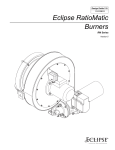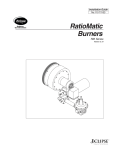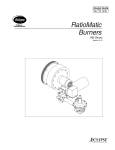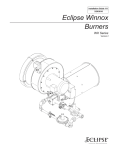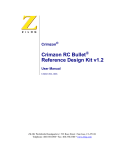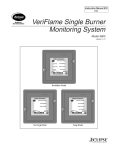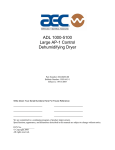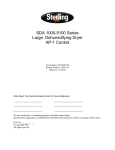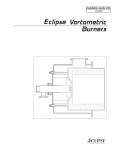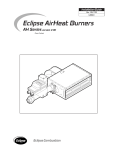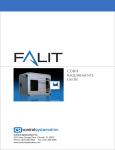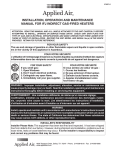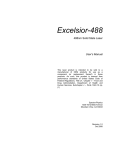Download Eclipse RatioMatic RM Series Installation guide
Transcript
Installation Guide 110
11/11/2011
Eclipse RatioMatic
Burners
RM Series
Version 5
Copyright
consequential, including but not limited to loss of use,
income, or damage to material arising in connection with
the sale, installation, use of, inability to use or the repair or
replacement of Eclipse’s products.
Copyright 2010 by Eclipse, Inc. All rights reserved
worldwide. This publication is protected by federal
regulation and shall not be copied, distributed,
transmitted, transcribed or translated into any human or
computer language, in any form or by any means, to any
third parties, without the express written consent of
Eclipse, Inc.
Any operation expressly prohibited in this manual, any
adjustment, or any assembly procedures not
recommended or authorized in these instructions shall
void the warranty.
Disclaimer Notice
Document Conventions
In accordance with the manufacturer’s policy of continual
product improvement, the product presented in this
brochure is subject to change without notice or obligation.
There are several special symbols in this document. You
must know their meaning and importance.
The material in this manual is believed adequate for the
intended use of the product. If the product is used for
purposes other than those specified herein, confirmation
of validity and suitability must be obtained. Eclipse
warrants that the product itself does not infringe upon any
United States patents. No further warranty is expressed or
implied.
Liability & Warranty
We have made every effort to make this manual as
accurate and complete as possible. Should you find errors
or omissions, please bring them to our attention so that we
may correct them. In this way we hope to improve our
product documentation for the benefit of our customers.
Please send your corrections and comments to our
Marketing Communications Manager.
It must be understood that Eclipse’s liability for its product,
whether due to breach of warranty, negligence, strict
liability, or otherwise is limited to the furnishing of
replacement parts. Eclipse will not be liable for any other
injury, loss, damage or expenses, whether direct or
The explanation of these symbols follows below. Please
read it thoroughly.
How To Get Help
If you need help, contact your local Eclipse representative.
You can also contact Eclipse at:
1665 Elmwood Rd.
Rockford, Illinois 61103 U.S.A.
Phone: 815-877-3031
Fax: 815-877-3336
http://www.eclipsenet.com
Please have the information on the product label available
when contacting the factory so we may better serve you.
www.eclipsenet.com
Product Name
Item #
S/N
DD MMM YYYY
This is the safety alert symbol. It is used to alert you to potential personal
injury hazards. Obey all safety messages that follow this symbol to avoid
possible injury or death.
Indicates a hazardous situation which, if not avoided, will result in death
or serious injury.
WARNING
Indicates a hazardous situation which, if not avoided, could result in
death or serious injury.
CAUTION
Indicates a hazardous situation which, if not avoided, could result in
minor or moderate injury.
NOTICE
NOTE
2
Is used to address practices not related to personal injury.
Indicates an important part of text. Read thoroughly.
Table of Contents
Introduction .............................................................................................. 4
Product Description....................................................................... 4
Audience ....................................................................................... 4
RatioMatic Documents .................................................................. 4
Purpose......................................................................................... 4
Safety ........................................................................................................ 5
Introduction ................................................................................... 5
Safety ............................................................................................ 5
Capabilities.................................................................................... 5
Operator Training .......................................................................... 5
Replacement Parts........................................................................ 5
Installation ................................................................................................ 6
Handling & Storage ....................................................................... 6
Approvals of Components............................................................. 6
Checklist Before Installation.......................................................... 7
Installing the Flame Sensor........................................................... 7
Burner Installation ......................................................................... 7
Gas Piping..................................................................................... 9
Checklist After Installation............................................................. 10
Adjustment, Start & Stop......................................................................... 11
Adjustment Procedure................................................................... 11
Step 1: Reset the System ............................................................. 11
Step 2: Set Low Fire Air ................................................................ 12
Step 3: Ignite the Burner (RM0050-RM0700 only)........................ 13
Step 4: Set Low Fire Gas (RM0050-RM0700 only)....................... 16
Step 5: Verify Settings (RM0050-RM0700 only) ........................... 17
Step 3: Ignite the Burner (RM1000-RM3000 only)........................ 18
Step 4: Set Low Fire Gas (RM1000-RM3000 only)....................... 18
Step 5: Verify Settings (RM1000-RM3000 only) ........................... 18
Maintenance & Troubleshooting ............................................................ 19
Monthly Checklist .......................................................................... 19
Yearly Checklist ............................................................................ 19
Troubleshooting ............................................................................ 20
Appendix................................................................................................... i
Conversion Factors ....................................................................... i
Key to System Schematics ........................................................... ii
Eclipse RatioMatic Burners, RM Series, V5, Installation Guide 110, 11/11/2011
3
1
Introduction
Product Description
The RatioMatic is a nozzle-mix type burner designed for
direct and indirect air heating and oven applications up to
1900°F(1040°C).
The burner package includes a combustion air blower and
an air/gas ratio regulator to fire over a wide gas turndown
range with controlled ratio.
The burner is designed for:
• Efficient Ratio Controlled Combustion
• Reliable Burner Operation
• Simple Burner Adjustment
• Direct Spark Ignition
• Multiple Fuel Capability
A wide variety of options and configurations are available
due to the modular design of the burner.
Audience
This manual has been written for people who are already
familiar with all aspects of a nozzle-mix burner and its addon components, also referred to as “the burner system”.
These aspects are:
• Installation
• Use
• Maintenance
Figure 1.1 RatioMatic Burner
RatioMatic Documents
Installation Guide No. 110
• This document
Datasheet, Series 110
• Available for individual RM models
• Required to complete design and selection
Design Guide No. 110
• Used with Datasheet to complete installation
The audience is expected to have previous experience
with this type of equipment.
Related Documents
• EFE 825 (Combustion Engineering Guide)
• Eclipse Bulletins and Info Guides: 710, 732, 742,
760, 818, 830, 832, 852, 854, 856, 610, 820, 902,
930
Purpose
The purpose of this manual is to ensure the installation
and adjustment of a safe, effective and trouble-free
combustion system.
4
Eclipse RatioMatic Burners, RM Series, V5, Installation Guide 110, 11/11/2011
2
Safety
Introduction
This section is provided as a guide for the safe operation
of the RatioMatic burner system. All involved personnel
should read this section carefully before operating this
system.
Safety
DANGER
■ The RatioMatic burners, described herein, are
designed to mix fuel with air and burn the resulting
mixture. All fuel burning devices are capable of
producing fires and explosions if improperly
applied, installed, adjusted, controlled, or
maintained.
■ Do not bypass any safety feature. Fires and
explosions can be caused.
■ Never try to light the burner if the burner shows
signs of damage or malfunctioning.
WARNING
■ The burner might have HOT surfaces. Always wear
protective clothing when approaching the burner.
■ Eclipse products are designed to minimize the use
of materials that contain crystalline silica.
Examples of these chemicals are: respirable
crystalline silica from bricks, cement or other
masonry products and respirable refractory
ceramic fibers from insulating blankets, boards, or
gaskets. Despite these efforts, dust created by
sanding, sawing, grinding, cutting, and other
construction activities could release crystalline
silica. Crystalline silica is known to cause cancer,
and health risks from the exposure to these
chemicals vary depending on the frequency and
length of exposure to these chemicals. To reduce
this risk, limit exposure to these chemicals, work
in a well-ventilated area and wear approved
personal protective safety equipment for these
chemicals.
NOTICE
■ This manual provides information in the use of
these burners for their specific design purpose. Do
not deviate from any instructions or application
limits described herein without written advice from
Eclipse. Read the entire manual before attempting
to start this system.
Capabilities
Adjustment, maintenance and troubleshooting of the
mechanical and the electrical parts of this system should
be done by qualified personnel with good mechanical
aptitude and experience with combustion equipment.
Operator Training
The best safety precaution is an alert and trained
operator. Train new operators thoroughly and have them
demonstrate an adequate understanding of the
equipment and its operation. A regular retraining schedule
should be administered to ensure operators maintain a
high degree of proficiency.
Replacement Parts
Order replacement parts from Eclipse only. All Eclipse
approved, customer supplied valves or switches should
carry UL, FM, CSA, CGA, and/or CE approval, where
applicable.
Eclipse RatioMatic Burners, RM Series, V5, Installation Guide 110, 11/11/2011
5
3
Installation
In this section you will find information and instructions
needed to install the burner and system components.
Handling & Storage
Handling
Where to Get the Standards:
• Make sure that the area is clean.
• Protect all components from weather, damage, dirt
and moisture.
• Protect the components from excessive
temperatures and humidity.
• Take care not to drop or damage components.
Storage
• Make sure the components are clean and free of
damage.
• Store the components in a cool, clean, dry room.
• After you have made sure everything is present and
in good condition, keep the components in their
original packaging as long as possible
Approval of Components
Limit Controls & Safety Equipment
All limit controls and safety equipment must comply with
all applicable local codes and/or standards and must be
listed for combustion safety by an independent testing
agency. Typical application examples include:
• American: NFPA 86 with listing marks from UL, FM,
CSA
• European: EN 746-2 with CE mark from TuV,
Gastec, Advantica
Electrical Wiring
All the electrical wiring must comply with all applicable
local codes and/or standards such as:
•
•
•
•
• NFPA Standard 54
• ANSI Z223
• EN 746-2
NFPA Standard 70
IEC60364
CSA C22
BS7671
The NFPA Standards are available from:
National Fire Protection Agency
Batterymarch Park
Quincy, MA 02269
www.nfpa.org
The ANSI Standards are available from:
American National Standard Institute
1430 Broadway
New York, NY 10018
www.ansi.org
The UL Standards are available from:
333 Pfingsten Road
Northbrook, IL 60062
www.ul.com
The FM Standards are available from:
1151 Boston-Providence Turnpike
PO Box 9102
Norwood, MA 02062
www.fmglobal.com/approvals
Information on the EN standards and where to get them is
available from:
Comité Européen de Normalisation
Stassartstraat 36
B-1050 Brussels
Phone: +32-25196811
Fax: +32-25196819
www.cen.eu
Comité Européen de Normalisation Electronique
Stassartstraat 36
B-1050 Brussels
Phone: +32-25196871
Fax: +32-25196919
www.cenelec.org
Gas Piping
All the gas piping must comply with all applicable local
codes and/or standards such as:
6
Eclipse RatioMatic Burners, RM Series, V5, Installation Guide 110, 11/11/2011
Checklist Before Installation
Air Supply
Provide an opening in the burner room of at least one
square inch per 4000 BTU/hr (6 cm2 per 1 kW) to supply
the burner intake with fresh, outdoor, combustion air.
If there are corrosive fumes or materials in the
surrounding air, find an uncontaminated source to supply
air to the burner, or provide a sufficient air filtering system.
Flame Rod
NOTE: Only specific burner sizes with alloy or silicon
carbide combustors can use a flamerod (see specific
burner datasheets).
For detailed information on how to install and connect a
flamerod, refer to Bulletin/Info guide 832.
Installing the Spark Plug
Install the spark plug into the opening in the rear cover.
Exhaust
Do not allow exhaust fumes to accumulate in the work
area. Provide some positive means for exhausting from
the furnace and the building.
NOTE: Do not apply any grease to the threads of the
spark plug or bad grounding of the spark plug may occur,
resulting in a weak spark.
Access
NOTICE
Make sure the burner is installed in such a way to allow
easy access for inspection and maintenance.
Environment
Make sure the local environment matches the original
operating specifications. Check the following items:
• Voltage, frequency and stability of the electrical
power
• Fuel type and supply pressure of the fuel
• Availability of enough fresh, clean combustion air
• Humidity, altitude and temperature of air
• Presence of damaging corrosive gases in the air
• Prevent direct exposure to water
■ Adjustments may vary from Eclipse published
values if the flame controls other than those
recommended in the Design Guide are used.
Consult with the engineer who specified the
alternate control for limitations.
Burner Installation
Chamber Opening
Minimum 1/4" (6mm)
space per side
Installing the Flame Sensor
1. Install the flame sensor into the 1/2" NPT opening in the
rear cover.
Combustor
2. Make sure the flame sensor of a burner is connected to
the electrical circuit for that burner.
Chamber Wall
Figure 3.1.
DANGER
■ If you connect the flame sensor of a burner to the
electrical circuit of the wrong burner, you can
cause fires and explosions.
Provide an opening in the chamber wall at least 1/2"
(12mm) larger in diameter than the outside diameter of the
combustor, or 1/2" (12mm) larger in height and width than
the square refractory block. (1/4" - 6mm per side).
There are two different types of flame sensors; UV
scanner and flamerod.
Provide an accessible pressure tap on the chamber wall
to measure the pressure inside the firing chamber. The
pressure tap should be located near the burner.
UV Scanner
Mounting Pattern
The UV Scanner must be compatible to the flame
monitoring control that is used. Refer to the manual of
your selected control for proper selection of the scanner.
Attach mounting bolts to the chamber wall. Position these
bolts to match the clearance holes “C” on the burner
mounting flange. Refer to the appropriate RatioMatic
datasheet.
Eclipse RatioMatic Burners, RM Series, V5, Installation Guide 110, 11/11/2011
7
“C”
“C”
CAUTION
■ Placing insulation around the combustor beyond
the burner nozzle position will decrease
combustor life.
RM0050 - RM0700
RM1000 - RM3000
3. No gasket is supplied or required between the burner
and combustor.
Figure 3.2. Mounting Pattern
Chamber Wall
Silicon Carbide (SiC) Combustor Only
Make sure the chamber wall is strong enough to
support the weight of the burner . If necessary, reinforce
the mounting area.
If the chamber insulation extends beyond the nozzle
position of the burner, taper the insulation around the
combustor at a minimum 45° angle. Refer to Datasheets
to determine the position of the nozzle relative to the
chamber wall.
CAUTION
■ SiC combustor is fragile. Handle with care.
If the SiC combustor is not already attached to the burner,
be sure gasket is installed between the SiC combustor
and flange . Tighten the screws which hold the flange
to the burner evenly. Do not over tighten.
1
4
4
5
POSITION
NOZZLE
POSITION
45° Minimum
2
Fiber insulation
3
Chamber
Insulation
6
Figure 3.3. Chamber Wall
2
Figure 3.5. Silicon Carbide (SiC) Combustor
Burner Mounting
Mount burner to chamber wall using four (4 or 8) customer
supplied nuts and lock washers, as required.
Both Alloy and Silicon Carbide (SiC) Combustor
1. Be sure gasket is installed between burner
chamber wall .
and
2. Pack fiber insulation around the combustor to a depth
not beyond the nozzle position, as illustrated.
1
CAUTION
■ When replacing SiC combustor be sure gasket
is installed, tighten screws evenly, and do not use
excessive force.
Refractory Block
1. Ensure gasket is installed between burner
block holder .
and
2. Ensure gasket is installed between block holder
and chamber wall .
NOZZLE
POSITION
4
Fiber insulation
2
Chamber
insulation
3. Support the weight of refractory block with hard brick
work anchored to the furnace shell . Fill the 1/2"
space between block and the three unsupported
sides with soft gasket material .
Chamber
insulation
Figure 3.4. Alloy Combustor
8
Eclipse RatioMatic Burners, RM Series, V5, Installation Guide 110, 11/11/2011
7
3
Gas Piping
Burner Piping
1
The burner is factory assembled and shipped as ordered.
4
NOZZLE
POSITION
NOTE: If it is necessary to redirect piping, be sure the:
• ratio regulator spring column is pointing up.
• arrow on the ratio regulator points in the direction of
gas flow.
• integral fuel orifice and o-rings are re-installed in
the same orientation with respect to the fuel flow.
• same straight run of pipe remains between the
ratio regulator and the burner.
8
2
9
10
Figure 3.6. Refractory Block
Large Refractory Blocks
On sizes RM0300 through RM3000; the block must be
tightly surrounded by a collar made of brick, plastic
refractory, or a castable refractory of at least 4" (10 cm)
minimum thickness on all sides of the block. If the collar is
cast around the block, a thin plastic film (i.e. Saran Wrap®
or Glad Wrap®) should be wrapped around the block to
keep moisture from leaching into it. The collar should be
anchored to the furnace shell with suitable anchors and
must be constructed to rest on a surface capable of
supporting its weight, such as a hearth or a solid refractory
or brick wall. For furnaces that are unable to support the
weight of the refractory block, a stainless steel shelf can be
welded to the shell to support the collar.
NOTE: All refractory blocks are cured at a minimum
temperature of 550°F (300°C) prior to shipment.
Figure 3.7. Burner Piping
Supply Piping
Inlet pressure to the ratio regulator must stay within
specified limits. Refer to the appropriate RatioMatic
datasheet.
NOTE: The correct insulation of burner combustion blocks
in furnaces results in longer block life and adds value by
reducing downtime and maintenance.
• Locate the valve train close to the burner. The gas
must reach the burner during the fixed trial for
ignition.
• Appropriately size shut off valves in the valve train.
• Make sure piping is large enough to accommodate
flow required to meet burner input.
• Minimize piping elbows.
• If a reducing nipple is necessary, install it at the inlet
to the burner proportionator. Do not use a reducing
bushing in the proportionator inlet.
Block Holder Temperature
Excessive block holder temperatures can cause
problems. Overheating can be reduced by carefully
sealing the burner blocks in the wall to prevent the
leakage of hot gases back to the furnace shell.
In high temperature (>1,400°F, 760°C) fiber-wall furnace
installations, the length of the metallic wrapper should
extend no farther than the point in the wall where the
interface temperature is higher than 1800°F (760°C).
Vertical Down Firing Blocks (Figure 3.6)
Bypass Start Gas Piping (Optional for RM0050RM0700 Only)
Install the piping as shown in the schematics using the
following guidelines:
1. Down firing blocks may be suspended by customer
supplied hangers attached to the burner body mounting
bolts.
2. Hangers should be attached to structural support.
Eclipse RatioMatic Burners, RM Series, V5, Installation Guide 110, 11/11/2011
• Locate the bypass start gas solenoids close to the
burner. The gas must reach the burner during the
trial for ignition period.
• Minimize piping elbows.
9
• Install an adjustable limiting orifice (ALO) for start
gas adjustment. Refer to Bulletin 728 and 730 for
further information.
• Include a straight run of pipe at least 8" (192mm)
long before (upstream from) the start gas orifice
(optional) and at least 4" (96mm) long after
(downstream from) the start gas orifice.
NC
Use brackets or hangers to support the gas piping. If you
have questions, consult your local gas company.
Control Motor
Install a control motor to modulate the air butterfly valve if
not previously installed on the burner.
NOTE: Be sure the control motor shaft and air butterfly
valve shaft are aligned properly. In some cases washers
may be used as shims (stacked 0, 1, or 2 high) to ensure
proper alignment. Additionally, a flexible coupling can be
used to handle minor misalignment.
Main gas
shut-off
valve train
Piping Support
NC
BV
Shaft
Figure 3.8. Bypass Start Gas Piping
Set
Screws
NOTICE
Motor
Shaft
Control
Motor
■ Please verify that piping complies with all
applicable codes and/or standards.
Pilot Valve Trains (RM1000-RM3000)
The pilot gas valve train should be connected as close as
possible to the pilot adjusting cock.
Coupling
Pipe Connections
• Installation of a pipe union in the gas line is
recommended to simplify burner removal.
• Use of flexible pipe is optional.
Figure 3.10. Control Motor Mounting
Checklist After Installation
NOTE: Flexible pipe causes higher pressure drops than
standard pipe. Consider this when sizing your gas lines.
To verify the system was properly installed, perform the
following checks:
1. Be sure there are no leaks in the gas lines.
2. Be sure all the components contained in the flame
monitoring and control system are properly installed.
This includes verifying that:
• all the switches are installed in the correct locations.
• all wiring, pressure, and impulse lines are properly
connected.
3. Be sure all components of the spark ignition system are
installed and functioning properly.
Bracket
Pipe Union
Figure 3.9. Piping Connections
10
4. Be sure the blower rotates in the proper direction. If the
rotation is incorrect, have a qualified electrician rewire
the blower to rotate in the proper direction.
5. Be sure all valves are installed in the proper location
and correctly oriented relative to the flow direction.
Eclipse RatioMatic Burners, RM Series, V5, Installation Guide 110, 11/11/2011
Adjustment, Start &
Stop
DANGER
■ The RatioMatic burners, described herein, are
designed to mix fuel with air and burn the resulting
mixture. All fuel burning devices are capable of
producing fires and explosions if improperly
applied, installed, adjusted, controlled, or
maintained.
■ Do not bypass any safety features. This can cause
fires and explosions.
■ Never try to light a burner if it shows signs of
damage or malfunction.
Adjustment Procedure
If you are adjusting the burner system for the first time,
then you must follow these steps:
Step 1: Reset the System
1. Set the low gas pressure switch to 20% below the
“Main Gas Inlet Pressure” range as specified in the
appropriate datasheet.
6. If the burner is firing into a duct or chamber with a
circulating fan, start the fan to produce a full process
air flow past the burner.
7. Adjust main gas inlet pressure to the ratio regulator
within the range specified in the appropriate
datasheet.
WARNING
■ Gas inlet pressures must stay within the specified
range. Pressure above the specified range can
damage the ratio regulator.
■ Pressure below the specified range can impair the
ability of the ratio regulator to control the gas flow.
■ Operating the system outside the specified range
can cause excess fuel consumption and the
possible accumulation of unburned fuel in the
chamber. In extreme cases, this accumulation of
unburned fuel may cause fires or explosions.
8. Verify that the actuator opens the air BV towards the
back of the burner as shown in Figure 4.1. If it doesn’t,
refer to the actuator’s literature for instructions on how
to reverse the direction.
2. Set the high gas pressure switch to 20% above the
“Main Gas Inlet Pressure” range as specified in the
appropriate datasheet.
3. Close all the burner gas valves, manual and
automatic.
Back
In this chapter, you will find instructions on how to adjust,
start, and stop the burner system. Become familiar with
burner control methods before attempting to make
adjustments.
4
4. Try to ignite the burner; be sure the flame monitoring
system indicates a flame failure.
5. Activate the pressure switches and other limit
interlocks. Be sure the switches fail as intended in the
event of a power failure.
■ If simulated limits or simulated flame failure do not
shut down the fuel system within the required
failure response time, immediately correct the
problem before proceeding.
Eclipse RatioMatic Burners, RM Series, V5, Installation Guide 110, 11/11/2011
Open in this
direction only
Open
DANGER
Closed
Figure 4.1. Air Butterfly Valve
11
Step 2: Set Low Fire Air
1. Start combustion air blower.
2. Drive control motor to low fire position.
3. Measure air differential pressure between tap “C” and
combustion chamber. See the appropriate series 110,
datasheet.
To Chamber
Figure 4.2.
When firing into a positive chamber pressure,
rotate the air butterfly valve from the closed position
in the direction of actuator travel to obtain a
minimum
0.3" w.c. (0,8 mbar) air differential pressure.
d. For air control actuators that have a coupling with
set screws, as shown in Figure 4.3, hold the
butterfly valve firmly in place and tighten the set
screw .
For air control actuators that have a keyed or
pinned coupling, as shown in Figure 4.4, hold the
butterfly valve firmly in place and re-engage the
cam’s low or off starting position.
• For T500 series Trilogy Actuators, see Instruction
Manual 902 or Quick Guide 902.
e. High fire air adjustment is not required if the burner
is firing into a neutral pressure chamber and a 90°
travel control motor is used. It may be necessary to
limit control motor stroke to less than 90° if firing
into a large negative chamber. Contact Eclipse for
further information.
Figure 4.3. Actuator with Flexible Coupling
NOTE (RM0050-RM0700): The pressure tap is in the
open position when the screw inside the tap is unscrewed
approximately 1/2 turn. Do not remove screw. Be sure to
tighten pressure tap screw clockwise to the closed
position after pressure measurements have been taken.
4. Set low fire air.
a. For air control actuators that have a coupling with
set screws, as shown in Figure 4.3, loosen the set
screw on the burner side of the coupling .
For air controlled actuators that have a keyed or
pinned coupling, as shown in Figure 4.4, please
refer to the cam adjustment section of the
actuator’s installation literature for instructions on
releasing the cam’s low or off start position.
• For T500 series Trilogy Actuators, see Instruction
Manual 902 or Quick Guide 902.
b. There is a slot in the end of the butterfly valve shaft
that is parallel to the air damper. This slot is used
for visual indication of the butterfly valve position.
The butterfly valve is closed when the shaft slot is
perpendicular to the direction of air flow through
the butterfly valve. See Figure 4.5
c. Rotate the air butterfly valve shaft to a fully closed
position. (Holes in the butterfly valve will supply
low fire air.)
12
Figure 4.4. Actuator with Keyed Coupling
5. Verify high fire air:
a. Drive control motor to high fire, full open.
b. Compare the high fire air differential pressure
between Tap C and the combustion chamber to
the approximate datasheet chart “Air p vs. Input”.
If high fire air is insufficient, refer to section 5,
“Troubleshooting & Maintenance”, in this
document.
6. Return the control motor to the low fire position.
7. Close the pressure taps.
Eclipse RatioMatic Burners, RM Series, V5, Installation Guide 110, 11/11/2011
Step 3: Ignite the Burner (RM0050-RM0700
only)
WARNING
■ This procedure is written with the assumption the
burner has a flame monitoring control system
installed and operating. A proper purge cycle must
be part of the system and purge timing should not
be bypassed.
BV shaft shown in
closed position
Figure 4.5. Air Butterfly Valve Shaft
NOTE: Steps 3-5 RM0050-RM0700 Only (see page 18 for
RM1000-RM3000)
Low fire start without high turndown option Procedure “A”.
Determine system layout and use the applicable ignition
procedure.
Low fire start with high turndown option Procedure “B”.
Ratio regulator
with bypass
adjusting screw
Main gas
shut-off
valve train
Main gas
shut-off
valve train
NOTE: The ratio regulator is factory set. Use Procedure “A”
only if burner does not ignite or requires further adjustment.
NOTE: The RatioAir burner with high turn down option
includes a ratio regulator with internal bypass adjustment.
Bypass start gas without fuel orifice meter Procedure “C”.
Bypass start gas with fuel orifice meter Procedure “D”.
Main gas
shut-off
valve train
NC
Main gas
shut-off
valve train
NC
NC
NC
Figure 4.6.
Eclipse RatioMatic Burners, RM Series, V5, Installation Guide 110, 11/11/2011
13
Procedure A: Low fire start without high turndown
option
8. Flame signal strength: Adjust gas flow with bias
adjusting screw for lowest gas flow that maintains
a stable flame signal:
• clockwise, for more fuel
• counterclockwise, for less fuel
9. Verify low fire flame:
a. Shut off gas. When chamber temperature is below
250°F (121°C), shut off combustion air blower.
b. Restart combustion air blower and ignite burner.
c. Verify repeatability of ignition and low fire flame
signal.
Procedure B: Low fire start with high turndown option
Main gas
shut-off
valve train
Figure 4.7. Procedure A
1. Drive control motor to low fire.
2. Be sure combustion air blower is running.
3. Verify bias adjusting screw on ratio-regulator spring
column is six full clockwise turns (360° x 6) down from
the top (initial setting).
Ratio regulator
with bypass
adjusting screw
Main gas
shut-off
valve train
Figure 4.9. Procedure B
CW for
more gas
Bias
Adjusting
Screw
NOTE: The RatioMatic burner with high turndown option
includes a ratio regulator with internal bypass adjustment.
1. Drive control motor to low fire.
2. Be sure combustion air blower is running.
3. Verify bias adjusting screw on ratio-regulator spring
column is six full clockwise turns (360° x 6) down from
top (initial setting).
4. Open main gas manual shut off valves.
Figure 4.8. Ratio Regulator
CW for
more gas
4. Open main gas manual shut off valves.
5. Set system control to stay at low fire during and after
ignition sequence.
1 Bias
adjusting
screw
6. Attempt to ignite burner.
7. If burner does not ignite:
a. Attempt to ignite burner again to purge air from the
gas piping.
b. If burner still does not ignite, turn bias adjusting
screw a half turn clockwise to increase gas flow.
c. Attempt to ignite burner.
d. Repeat steps b and c until burner ignites. If
necessary, refer to Chapter 5 for troubleshooting
tips.
14
CCW for
more gas
2
Internal bypass
adjusting screw
Figure 4.10. Ratio Regulator with Internal
Bypass Adjusting Screw
Eclipse RatioMatic Burners, RM Series, V5, Installation Guide 110, 11/11/2011
5. Close internal bypass adjusting screw by turning it
clockwise to closed position.
1. Drive control motor to low fire.
6. Set system control to stay at low fire during and after
ignition sequence.
3. Be sure main gas manual shut off valves are closed.
7. Attempt to ignite burner.
2. Be sure combustion air blower is running.
4. Open main gas manual shut off valve in the bypass.
8. If burner does not ignite:
a. Attempt to ignite burner again to purge air from the
gas piping.
b. If burner still does not ignite, turn bias adjusting
screw a half turn clockwise to increase gas flow.
c. Attempt to ignite burner.
d. Repeat steps b and c until burner ignites. If
necessary, refer to Chapter 5 for troubleshooting
tips.
9. After burner ignites, slowly decrease gas flow with
bias adjusting screw . Decrease gas flow until the
flame signal becomes erratic. (Refer to flame
monitoring relay literature for a description of an
erratic flame signal.)
10. If burner has gone out: Repeat ignition sequence.
Turn internal bypass adjusting screw a half turn
counterclockwise to increase gas flow at each attempt
until burner lights.
11. Flame signal strength: Adjust gas flow with internal
bypass adjusting screw for lowest gas flow that
maintains a stable flame signal:
• clockwise, for more fuel
• counterclockwise, for less fuel
12. Verify low fire flame:
a. Shut off gas. When chamber temperature is below
250°F (121°C), shut off combustion air blower.
b. Restart combustion air blower and ignite burner.
c. Verify repeatability of ignition and low fire flame
signal.
Procedure C: Bypass start gas without fuel orifice
meter
ALO Adjusting
Screw
CCW for
more gas
Cap
Figure 4.12. Adjusting Limiting Orifice (ALO)
5. Set the system to operate on bypass gas only.
6. Attempt to ignite burner by energizing spark and
bypass gas solenoid valves .
7. If burner does not ignite:
a. Attempt to ignite burner again to purge air from the
gas piping.
b. If burner still does not ignite, turn ALO adjusting
screw a half turn counterclockwise to increase
gas flow.
c. Attempt to ignite burner.
d. Repeat steps b and c until burner ignites. If
necessary, refer to Chapter 5 for troubleshooting
tips.
8. Flame signal strength: Adjust gas flow ALO adjusting
screw for lowest gas flow that maintains a stable
flame signal:
• counterclockwise, for more fuel
• clockwise, for less fuel
9. Verify low fire flame:
a. Shut off gas. When chamber temperature is below
250°F (121°C), shut off combustion air blower.
b. Restart combustion air blower and ignite burner.
c. Verify repeatability of ignition and low fire flame
signal.
Main gas
shut-off
valve train
NC
NC
Figure 4.11. Procedure C
Eclipse RatioMatic Burners, RM Series, V5, Installation Guide 110, 11/11/2011
15
Procedure D: Bypass start gas with fuel orifice meter
9. Adjust bypass gas flow with ALO adjusting screw to
achieve the low fire gas flow indicated on datasheet.
Refer to the fuel orifice meter literature for instructions
on flow measurement.
NOTE: When firing into negative or fluctuating chamber
pressures, a higher bypass gas flow may be necessary.
10. Verify the bypass gas flame:
a. Shut off gas. When chamber temperature is below
250°F (121°C), shut off combustion air blower.
b. Restart combustion air blower and ignite burner.
c. Verify repeatability of ignition and low fire flame
signal.
Main gas
shut-off
valve train
NC
NC
Step 4: Set Low Fire Gas (RM0050-RM0700
only)
(Only required if Bypass Start is Used)
Figure 4.13. Procedure D
1. Drive control motor to low fire.
WARNING
2. Be sure combustion air blower is running.
3. Be sure main gas manual shut off valves are closed.
4. Prepare to measure bypass gas flow at the fuel orifice
meter .
5. Open manual shut off valve in the bypass.
6. Set the system to operate on bypass gas only.
7. Attempt to ignite burner by energizing spark and
bypass gas solenoid valves .
■ This procedure is written with the assumption the
burner has a flame monitoring control system
installed and operating. A proper purge cycle must
be part of the system control and purge timing
should not be bypassed.
This step is only necessary when bypass start gas is used.
Determine the piping method (low fire or bypass) and ratio
regulator installed (standard or high turndown), and
proceed with the applicable procedure:
Bypass Start Gas with Standard Turndown Ratio
Regulator
CW for
more gas
Bias
Adjusting
Screw
Figure 4.14. Adjusting Limiting Orifice (ALO)
8. If burner does not ignite:
a. Attempt to ignite burner again to purge air from the
gas piping.
b. If burner still does not ignite, turn ALO adjusting
screw a half turn counterclockwise to increase
gas flow.
c. Attempt to ignite burner.
d. Repeat steps b and c until burner ignites. If
necessary, refer to Chapter 5 for troubleshooting
tips.
16
Figure 4.15. Ratio Regulator
1. Verify bias adjusting screw on ratio regulator spring
column in six full clockwise turns (360° x 6) down from
the top (initial setting), five turns for the RA0025.
2. Open all manual gas shut off valves.
3. Set system control to stay at low fire during and after
ignition sequence.
Eclipse RatioMatic Burners, RM Series, V5, Installation Guide 110, 11/11/2011
4. Ignite the burner.
5. If burner goes out due to main gas flame failure, turn
bias adjusting screw a half turn clockwise to
increase gas flow. Repeat ignition sequence until
burner lights.
6. Flame signal strength: adjust gas flow with bias
adjusting screw for lowest gas flow that maintains
a stable flame signal:
• clockwise, for more fuel
• counterclockwise, for less fuel
7. Verify low fire flame:
8. If burner has gone out, repeat ignition sequence. Turn
internal bypass adjusting screw a half turn
counterclockwise to increase gas flow at each attempt
until burner lights.
9. Flame signal strength, adjust gas flow with internal
bypass adjusting screw for lowest gas flow that
maintains a stable flame signal:
• counterclockwise, for more fuel
• clockwise, for less fuel
10. Verify low fire flame:
a. Drive the control motor from low fire and back.
Verify low fire and stable flame signal are
repeated.
b. Turn the burner off and repeat the ignition
sequence. Verify low fire and stable flame signal
are repeated.
a. Drive control motor from low fire and back. Verify
low fire and stable flame signal are repeated.
b. Turn the burner off and repeat the ignition
sequence. Verify low flow and stable flame signal
are repeated.
Bypass Start Gas with High Turndown Option
CW for
more gas
Step 5: Verify Air Settings (RM0050-RM0700
only)
NOTE: There are no high fire gas adjustments or air
adjustments when firing into a neutral chamber. However,
air and gas pressures can be used to verify the burner
system is properly adjusted.
1 Bias
adjusting
screw
CCW for
more gas
2
Tap C
Internal bypass
adjusting screw
Figure 4.16. Ratio Regulator with
Internal Bypass Adjusting Screw
1. Verify bias adjusting screw on ratio regulator spring
column in six full clockwise turns (360° x 6) down from
the top (initial setting).
Chamber
Tap D
2. Open all manual shut off valves.
Tap B
3. Close internal bypass adjusting screw by turning it
clockwise to closed position.
4. Set system control to stay at low fire during and after
ignition sequence.
5. Ignite the burner.
6. If burner goes out due to main gas flame failure, turn
bias adjusting screw a half turn clockwise to
increase gas flow. Repeat ignition sequence until
burner lights.
7. Slowly decrease gas flow with bias adjusting screw .
Decrease gas flow until the flame signal becomes
erratic. (Refer to flame monitoring relay literature for a
description of an erratic flame signal.)
Figure 4.17. Setting Verification
1. With burner lit, drive control motor to high fire.
2. Wait for the chamber to reach normal operating
conditions (e.g. chamber temperature, process flows,
etc.).
3. Measure high fire fuel differential pressure between
tap “B” and tap “D”. this to the “Fuel Orifice P vs.
Input” graph on the datasheet.
4. Measure high fire air differential pressure between tap
“C” and the chamber. this pressure to the “Air P vs.
Air Flow” graph on the datasheet.
Eclipse RatioMatic Burners, RM Series, V5, Installation Guide 110, 11/11/2011
17
5. Drive the control motor to low fire and verify low fire
flame signal and flame appearance (if viewing).
NOTE: Gas pressure at low fire will be too low to measure
and verify the fuel settings.
5. After adjusting the low fire flame, return to high fire
and check gas differential pressure as described in
Step 4
.
CAUTION
6. Cycle burner from high to low several times to check
repeatability of settings.
7. Readjust burner if the settings do not repeat as
expected. If necessary refer to Chapter 5,
Maintenance & Troubleshooting.
■ Do not turn the blower off until the chamber
temperature is below 250°F (121°C). This will
prevent hot gases from flowing back through the
burner and blower and damaging them.
8. Record all setup data as an aid for future
troubleshooting and setup operations.
9. Stop the burner.
NOTE: Steps 3-5 RM1000-RM3000 Only (see page 13 for
RM0050-RM0700)
Step 3: Adjust Pilot (RM1000-RM3000 only)
Pilot Valve
1. Drive the control motor to low fire and set the system
to operate on pilot only
2. Turn the handle of the pilot adjusting cock open to
light the pilot.
3. Turn
the
internal
screw
(Figure
4.18)
counterclockwise to increase flow, clockwise to
decrease flow, until the pilot gives reliable ignition and
a steady flame signal with minimum pilot gas flow.
t
Figure 4.18. Pilot Valve Adjustmen
Step 4: Set High Fire Gas (RM1000-RM3000
only)
1. With the pilot lit and the control motor in the low fire
position, open the main gas shut-off valve. The main
flame should light.
2. Drive the control motor to its high fire position.
3. Measure the gas differential pressure as shown in
Figure 4.19.
4. If necessary, adjust the gas flow with the butterfly
valve. The flame should be clear blue. If the flame is
yellow, see Troubleshooting, page 20.
Step 5: Adjust Low Fire Flame (RM1000RM3000 only)
Measure differential
pressure between here
and tap in chamber wall
Figure 4.19. High Fire Differential
Gas Pressure
1. Return the control motor to the low fire position.
2. Check the combustion air differential pressure as
discussed in Step 2.
3. Gas pressure drop across the burner will be too low to
read reliably, but the flame should be clear blue,
entirely within the firing tube, and tight on the burner
head.
4. If necessary, adjust the ratio regulator bias screw as
shown in Figure 4.20 to obtain the proper low fire
flame. If the flame cannot be viewed, adjust the bias
screw to produce the minimum gas flow that will
generate a steady flame detector signal of sufficient
strength.
18
CW for
more gas
Bias
Adjusting
Screw
Figure 4.20. Ratio Regulator
Eclipse RatioMatic Burners, RM Series, V5, Installation Guide 110, 11/11/2011
Maintenance &
Troubleshooting
5
This section is divided into two parts. The first part
describes the maintenance procedures, and the second
part helps you to identify problems that may occur and
gives advice on how to solve these problems.
4. Inspect impulse piping for leaks.
Preventative maintenance is the key to a reliable, safe
and efficient system. The following are suggested
guidelines for periodic maintenance. Burners in severe
environments or operational conditions should be
checked more frequently.
7. Be sure the following components are not damaged or
distorted:
NOTE: The monthly and yearly lists are an average
interval. If your environment is dirty, then the intervals may
be shorter. Check with local authorities having jurisdiction
on their recommended maintenance schedules.
Monthly Checklist
1. Inspect flame-sensing devices for good condition and
cleanliness.
5. Clean and inspect all burners.
6. Remove and clean the orifice plate , see Figure 5.1.
• the burner nozzle
• the igniter
• the flame sensors
• the combustion tube or block
The nozzle and combustion tube/block can be inspected
without removing the burner from the chamber wall or
entering the chamber. See Figure 5.1. Perform the
following:
2. Check for proper air/gas pressures (refer to the
RatioMatic Datasheets, Series 115).
3. Test all the system alarms for proper response signals.
4. Check and clean igniter electrodes.
5. Check the air control valve for smooth, trouble free
operation and adjustment.
6. Check for
equipment.
the
proper
operation
of
ventilating
a. Shut the burner off and manually close the main
gas shut off cocks.
b. Allow the chamber temperature to cool down to
250°F (121°C).
c. Disconnect the gas piping at a union or the gas
inlet flange provided on the burner.
d. Remove the rear cover bolts .
e. Remove the rear cover from the burner
housing .
f. To re-assemble, follow this sequence in the
reverse order.
7. Test the interlock sequence on all safety equipment.
Manually force each interlock to intentionally fail while
at the same time noting if related equipment closes or
stops as specified by the manufacturer. Test the flame
safeguard by manually shutting off the gas to the
burner.
8. Test the manual gas shut off cocks for proper operation.
9. Clean and/or replace the combustion air blower filter.
10.Inspect and clean the combustion air blower rotor.
Yearly Checklist
1. Test (leak test) safety shut-off valves for tightness of
closure.
2. Test pressure switch settings by checking switch
movements against pressure settings and comparing
these with the actual impulse pressure.
Figure 5.1.
3. Visually check ignition cable and connectors.
Eclipse RatioMatic Burners, RM Series, V5, Installation Guide 110, 11/11/2011
19
Troubleshooting
Problem
Start-up sequence runs but
burner does not light.
Possible Cause
No ignition: There is no power to the ignition
transformer.
No ignition: Open circuit between the
ignition transformer and the igniter.
No ignition: The igniter needs cleaning.
No ignition: The igniter is not correctly
grounded to the burner.
No ignition: Igniter insulation is broken.
Igniter is grounding out.
Not enough gas: The gas pressure going
into the ratio regulator (RM0050-RM0700)
or pilot regulator (RM1000-RM3000) is too
low.
Not enough gas: The impulse line to the
ratio regulator is leaking.
Not enough gas: The pilot adjusting valve or
bypass valve is not open far enough.
Not enough gas: Start gas solenoid valve
does not open.
Not enough gas: Gas valve does not open.
Not enough gas: Ratio regulator is
incorrectly set.
No flame signal: Broken flamerod or dirty
UV scanner lens.
No flame signal: Spark plug and flamerod
reversed.
Too much gas: Wrong or missing burner
fuel orifice.
The low fire flame is weak or
Not enough gas flowing to the burner.
unstable.
Not enough air.
Solution
Restore the power to the ignition
transformer.
Repair or replace the wiring of the igniter.
Clean the igniter.
Clean the threads on the igniter and the
burner.
NOTE: Do not apply grease to the threads
on the igniter.
Inspect the igniter, replace if broken.
Check the start-up settings. Measure the
gas pressures and adjust where necessary.
Repair any leaks.
Adjust bypass or low fire gas.
Check the solenoid valve coil for proper
operation. Replace it if necessary.
Check the wiring to the automatic gas shutoff valve.
Check the output from the flame safeguard.
Open manual gas cock.
Adjust the ratio regulator to the proper
setting.
Inspect and clean sensor. Replace if
necessary.
Exchange spark plug / flamerod or their
wiring.
Check RatioMatic Datasheets, Series 115
for fuel orifice and given fuel.
Adjust the ratio regulator to increase the
gas flow.
Check for proper blower rotation.
Check air filter for blockage.
Compensate for chamber by opening the
low fire air butterfly valve position.
20
Eclipse RatioMatic Burners, RM Series, V5, Installation Guide 110, 11/11/2011
Problem
The burner goes out when it
cycles to high fire.
Possible Cause
Not enough gas pressure into the ratio
regulator.
Solution
Check the start-up settings.
Measure the gas pressures and adjust
them where necessary.
Check for valve train pressure loss.
Loading line to the ratio regulator is leaking. Repair the leak in the loading line.
Pilot set too lean, becoming unstable as air
Increase pressure into the pilot regulator.
increases.
Main gas adjusting valve not open enough. Increase valve opening.
Cross-connect pilot regulator vent to the
Suction or back pressure in chamber
combustion chamber, but not via the burner
fluctuates, upsetting pilot stability.
air pressure tap.
The burner is erratic and
does not respond to
adjustment.
Internal damage to the burner: Some parts
inside the burner are loose, dirty, or burned Contact Eclipse for further information.
out.
The burner is unstable or
Measure all the gas pressures and air
produces soot, smoke, or
pressures. Compare these pressures to the
The air/gas ratio is out of adjustment.
excessive carbon monoxide.
documented initial start-up settings and
adjust them where necessary.
The burner cannot achieve Air filter is blocked.
Clean or replace the air filter.
full capacity.
Gas pressure going into the ratio regulator
Adjust the gas pressure.
is too low.
Cannot initiate a start
Check air pressure switch adjustment.
sequence.
Check air filter.
Air pressure switch has not made contact.
Check blower rotation.
Check outlet pressure from blower.
Check incoming gas pressure.
High gas pressure switch has activated.
Adjust gas pressure if necessary.
Check pressure switch setting and
operation.
Check incoming gas pressure.
Low gas pressure switch has activated.
Adjust gas pressure if necessary.
Check pressure switch setting and
operation.
Malfunction of the flame safeguard system
Have a qualified electrician troubleshoot
(e.g. shorted out flame sensor or electrical
and correct the problem.
noise in the sensor line).
Have a qualified electrician troubleshoot
No power to the control unit.
and correct the problem.
Be sure the main power to the system is
Main power is off.
switched to the “on” position.
Main flame too long and
Gas butterfly valve is open too far or main
Gas flame is too high.
yellow at high fire.
gas regulator spring is screwed in too far.
Main flame too short at high
Gas butterfly valve is closed too far, or main
Gas flow is too low.
fire.
gas regulator spring is screwed out too far.
Low fire (pilot) flame is too
Main gas proportionator spring is set for too
long, soft or yellow.
much flow, or pilot gas cock adjustment is
open too far.
Too much gas flow.
Insufficient air flow due to dirty blow filter or
impeller.
Eclipse RatioMatic Burners, RM Series, V5, Installation Guide 110, 11/11/2011
21
Appendix
Conversion Factors
Metric to English
From
To
Multiply By
actual cubic meter/hr (am³/h)
actual cubic foot/hr (acfh)
35.31
normal cubic meter/hr (Nm³/h)
standard cubic foot /hr (scfh)
38.04
degrees Celsius (°C)
degrees Fahrenheit (°F)
(°C x 9/5) + 32
kilogram (kg)
pound (lb)
2.205
kilowatt (kW)
BTU/hr
3415
meter (m)
foot (ft)
3.281
millibar (mbar)
inches water column ("w.c.)
0.402
millibar (mbar)
pounds/sq in (psi)
14.5 x 10-3
millimeter (mm)
inch (in)
3.94 x 10-2
MJ/Nm³
BTU/ft³ (standard)
26.86
From
To
Multiply By
kiloPascals (kPa)
millibar (mbar)
10
meter (m)
millimeter (mm)
1000
millibar (mbar)
kiloPascals (kPa)
0.1
millimeter (mm)
meter (m)
0.001
From
To
Multiply By
actual cubic foot/hr (acfh)
actual cubic meter/hr (am³/h)
2.832 x 10-2
standard cubic foot /hr (scfh)
normal cubic meter/hr (Nm³/h)
2.629 x 10-2
degrees Fahrenheit (°F)
degrees Celsius (°C)
(°F - 32) x 5/9
pound (lb)
kilogram (kg)
0.454
BTU/hr
kilowatt (kW)
0.293 x 10-3
foot (ft)
meter (m)
0.3048
inches water column ("w.c.)
millibar (mbar)
2.489
pounds/sq in (psi)
millibar (mbar)
68.95
inch (in)
millimeter (mm)
25.4
BTU/ft³ (standard)
MJ/Nm³
37.2 x 10-3
Metric to Metric
English to Metric
i
Key to System Schematics
Symbol
Appearance
Name
Remarks
Bulletin/
Info Guide
RatioMatic
Main gas
shut-off
valve train
NC
Main Gas Shut-Off Valve Train
Eclipse strongly endorses NFPA
as a minimum.
756
Gas Cock
Gas cocks are used to manually
shut-off the gas supply on both
sides of the main gas shut-off
valve train.
710
Solenoid valves are used to
automatically shut off the gas
supply on a bypass gas system or
on small capacity burners.
760
Fuel Orifice Meter
Fuel orifice meters are used to
measure gas flow.
910
Adjustable Limiting Orifice
Adjustable limiting orifices are
used for fine adjustment of gas
flow.
Pressure Regulator
The pressure regulator reduces
gas pressure to a stable, usable
pressure.
684
A ratio regulator is used to control
the air/gas ratio. The ratio
regulator is a sealed unit that
adjusts the gas flow in ratio with
the air flow. To do this, it measures
the air pressure with a pressure
sensing line, the impulse line. This
impulse line is connected between
the top of the ratio regulator and
the burner body.
742
Solenoid Shut-Off Valve
(Normally Closed)
Dungs Ratio Regulator
Pressure Taps
Impulse Line
ii
Installation Guide 110, 11/11/2011
























